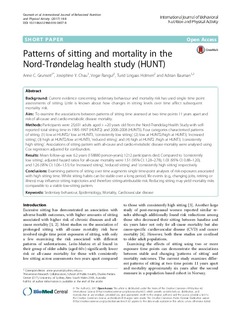| dc.contributor.author | Grunseit, Anne C. | |
| dc.contributor.author | Chau, Josephine Y. | |
| dc.contributor.author | Rangul, Vegar | |
| dc.contributor.author | Holmen, Turid Lingaas | |
| dc.contributor.author | Bauman, Adrian | |
| dc.date.accessioned | 2018-03-09T09:51:55Z | |
| dc.date.available | 2018-03-09T09:51:55Z | |
| dc.date.created | 2017-01-26T12:56:26Z | |
| dc.date.issued | 2017 | |
| dc.identifier.citation | International Journal of Behavioral Nutrition and Physical Activity. 2017, 14:8. | nb_NO |
| dc.identifier.issn | 1479-5868 | |
| dc.identifier.uri | http://hdl.handle.net/11250/2489695 | |
| dc.description.abstract | Background
Current evidence concerning sedentary behaviour and mortality risk has used single time point assessments of sitting. Little is known about how changes in sitting levels over time affect subsequent mortality risk.
Aim
To examine the associations between patterns of sitting time assessed at two time points 11 years apart and risk of all-cause and cardio-metabolic disease mortality.
Methods
Participants were 25,651 adults aged > =20 years old from the Nord-Trøndelag Health Study with self-reported total sitting time in 1995-1997 (HUNT2) and 2006-2008 (HUNT3). Four categories characterised patterns of sitting: (1) low at HUNT2/ low at HUNT3, ‘consistently low sitting’; (2) low at HUNT2/high at HUNT3, ‘increased sitting’; (3) high at HUNT2/low at HUNT3, ‘reduced sitting’; and (4) high at HUNT2 /high at HUNT3, ‘consistently high sitting’. Associations of sitting pattern with all-cause and cardio-metabolic disease mortality were analysed using Cox regression adjusted for confounders.
Results
Mean follow-up was 6.2 years (158880 person-years); 1212 participants died. Compared to ‘consistently low sitting’, adjusted hazard ratios for all-cause mortality were 1.51 (95% CI: 1.28–2.78), 1.03 (95% CI: 0.88–1.20), and 1.26 (95% CI: 1.06–1.51) for ‘increased sitting’, ‘reduced sitting’ and ‘consistently high sitting’ respectively.
Conclusions
Examining patterns of sitting over time augments single time-point analyses of risk exposures associated with high sitting time. Whilst sitting habits can be stable over a long period, life events (e.g., changing jobs, retiring or illness) may influence sitting trajectories and therefore sitting-attributable risk. Reducing sitting may yield mortality risks comparable to a stable low-sitting pattern. | nb_NO |
| dc.language.iso | eng | nb_NO |
| dc.publisher | BioMed Central | nb_NO |
| dc.rights | Navngivelse 4.0 Internasjonal | * |
| dc.rights.uri | http://creativecommons.org/licenses/by/4.0/deed.no | * |
| dc.title | Patterns of sitting and mortality in the Nord-Trøndelag health study (HUNT) | nb_NO |
| dc.type | Journal article | nb_NO |
| dc.type | Peer reviewed | nb_NO |
| dc.description.version | publishedVersion | nb_NO |
| dc.source.pagenumber | 1-7 | nb_NO |
| dc.source.volume | 14:8 | nb_NO |
| dc.source.journal | International Journal of Behavioral Nutrition and Physical Activity | nb_NO |
| dc.identifier.doi | 10.1186/s12966-016-0457-8 | |
| dc.identifier.cristin | 1438266 | |
| dc.description.localcode | © The Author(s). 2017 Open Access This article is distributed under the terms of the Creative Commons Attribution 4.0 International License (http://creativecommons.org/licenses/by/4.0/), which permits unrestricted use, distribution, and reproduction in any medium, provided you give appropriate credit to the original author(s) and the source, provide a link to the Creative Commons license, and indicate if changes were made. The Creative Commons Public Domain Dedication waiver (http://creativecommons.org/publicdomain/zero/1.0/) applies to the data made available in this article, unless otherwise stated. | nb_NO |
| cristin.unitcode | 194,65,20,15 | |
| cristin.unitcode | 194,65,20,0 | |
| cristin.unitname | Helseundersøkelsen i Nord-Trøndelag | |
| cristin.unitname | Institutt for samfunnsmedisin og sykepleie | |
| cristin.ispublished | true | |
| cristin.fulltext | original | |
| cristin.qualitycode | 2 | |

